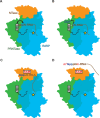Structural basis of paramyxo- and pneumovirus polymerase inhibition by non-nucleoside small-molecule antivirals
- PMID: 39162479
- PMCID: PMC11459973
- DOI: 10.1128/aac.00800-24
Structural basis of paramyxo- and pneumovirus polymerase inhibition by non-nucleoside small-molecule antivirals
Abstract
Small-molecule antivirals can be used as chemical probes to stabilize transitory conformational stages of viral target proteins, facilitating structural analyses. Here, we evaluate allosteric pneumo- and paramyxovirus polymerase inhibitors that have the potential to serve as chemical probes and aid the structural characterization of short-lived intermediate conformations of the polymerase complex. Of multiple inhibitor classes evaluated, we discuss in-depth distinct scaffolds that were selected based on well-understood structure-activity relationships, insight into resistance profiles, biochemical characterization of the mechanism of action, and photoaffinity-based target mapping. Each class is thought to block structural rearrangements of polymerase domains albeit target sites and docking poses are distinct. This review highlights validated druggable targets in the paramyxo- and pneumovirus polymerase proteins and discusses discrete structural stages of the polymerase complexes required for bioactivity.
Keywords: chemical probe; measles virus; mononegavirales; parainfluenza virus; paramyxovirus; pneumovirus; polymerase inhibitor; polymerase structure; respiratory syncytial virus; viral polymerase.
Conflict of interest statement
R.M.C. and R.K.P. are co-inventors on patent filings covering composition and method of use of GHP-88309 and its analogs for antiviral therapy. R.K.P. is a co-inventor on patent filings covering composition and method of use of AVG-233 and ERDRP-0519 and their analogs for antiviral therapy. This paper could affect their personal financial status. R.K.P. reports contract testing from Enanta Pharmaceuticals, Atea Pharmaceuticals, and Icosagen Biosciences and research support from Gilead Sciences, outside of the described work.
Figures











References
-
- Kuhn JH, Abe J, Adkins S, Alkhovsky SV, Avšič-Županc T, Ayllón MA, Bahl J, Balkema-Buschmann A, Ballinger MJ, Kumar Baranwal V, et al. . 2023. Annual (2023) taxonomic update of RNA-directed RNA polymerase-encoding negative-sense RNA viruses (realm Riboviria: kingdom Orthornavirae: phylum Negarnaviricota). J Gen Virol 104:001864. doi:10.1099/jgv.0.001864 - DOI - PMC - PubMed
-
- WHO . 2020. Worldwide measles deaths climb 50% from 2016 to 2019 claiming over 207 500 lives in 2019. World Health Organization. Available from: https://www.who.int/news/item/12-11-2020-worldwide-measles-deaths-climb-.... Retrieved Feb 21 Feb 2022.
Publication types
MeSH terms
Substances
Grants and funding
LinkOut - more resources
Full Text Sources

